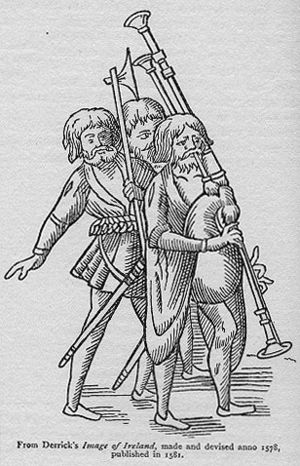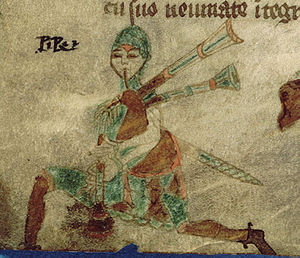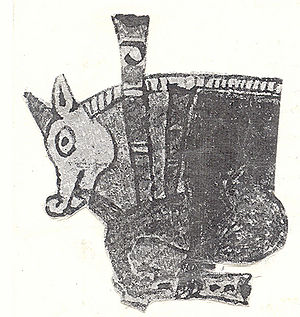
Great Irish Warpipes
Encyclopedia

Great Highland Bagpipe
The Great Highland Bagpipe is a type of bagpipe native to Scotland. It has achieved widespread recognition through its usage in the British military and in pipe bands throughout the world. It is closely related to the Great Irish Warpipes....
. "Warpipes" is an English term; The first use of the Gaelic term in Ireland is recorded in a poem by John O'Naughton (c. 1650-1728), in which the bagpipes are referred to as píb mhór. The píob mhór has a long and significant history in Ireland.
In Gaelic Ireland and Scotland, the bagpipe seems to have become an instrument of war no earlier than sometime in the 15th or early 16th century. An Irish Gaelic version of “Fierabas” may contain our first reference to Warpipes: the quote “sinnter adharca agus piba agaibh do tinol bur sluaigh” translates as “let horns and pipes be played by you to gather your host.” The manuscript may date to the 15th century and the writer may have had bagpipes in mind. Clear references to the Irish píob mhór begin to appear at about the same time as they do in Scotland. Our first relate to Henry VIII's siege of Boulogne. A muster roll of the “Kerne to be transported into Englaunde to serve the kinge” contains entries of various pipers attached to these forces, such as “The Baron of Delvene’s Kerne — Brene McGuntyre pyper”.
Most helpful is an entry in Holinshed’s Chronicles (1577) for May 1544: “In the same moneth also passed through the citie of London in warlike manner, to the number of seaven hundred Irishmen, having for their weapons darts and handguns with bagpipes before them: and in St. James Park besides Westminster they mustered before the king.”
In a 1581 volume, musician Vincenzo Galilei
Vincenzo Galilei
Vincenzo Galilei was an Italian lutenist, composer, and music theorist, and the father of the famous astronomer and physicist Galileo Galilei and of the lute virtuoso and composer Michelagnolo Galilei...
, the father of the astronomer Galileo, wrote that the bagpipe "is much used by the Irish: to its sound this unconquered fierce and warlike people march their armies and encourage each other to deeds of valor. With it they also accompany the dead to the grave making such sorrowful sounds as to invite, nay to compel the bystander to weep". In the same year, John Derricke published the poem "The Image of Ireland", in which the pipes are already used to convey signals in battle:
- Now goe the foes to wracke
- The Kerne apace doe sweate
- And baggepype then instead of Trompe
- Doe lull the back retreate
One famous description of the pipes from Richard Stanihurst's De Rebus Hibernicis (1586), reads as follows in English translation:
(Stanihurst clearly did not understand the proper functions of a chanter
Chanter
The chanter is the part of the bagpipe upon which the player creates the melody. It consists of a number of finger-holes, and in its simpler forms looks similar to a recorder...
and drones
Drone (music)
In music, a drone is a harmonic or monophonic effect or accompaniment where a note or chord is continuously sounded throughout most or all of a piece. The word drone is also used to refer to any part of a musical instrument that is just used to produce such an effect.-A musical effect:A drone...
).
The pipes seem to have figured prominently in the war with William of Orange. When the exiled King James II arrived in Cork City in March 1689, he was greeted with “bagpipes and dancing, throwing their mantles under his horse’s feet”. On his way to the castle in Dublin, “the pipers of the several companies played the Tune of The King enjoys his own again”.
On the other hand, there are late 17th century reports of peacetime use of the pipes, for example to play for hurling teams. For 18th century references, however, it is often difficult to tell whether the pipes referred to in a particular case are píob mhór or another instrument (eg. Pastoral/Uillean Pipes).
A number of Irish units are supposed to have had pipers for at least the next half-century; in 1778, a Barney Thompson (reportedly of Hillsborough, Co. Down) in Lord Rawdon’s Volunteers of Ireland in New York was supposedly the pipe major of a full band. Information from a muster roll indicates that there was at least a Piper Barney Thompson in the regiment. The fact that he is listed as a piper, while, for example, a William Neil is listed as a fifer, indicates that Thompson played bagpipes and not a fife. In 1793, according to a 7 September Dublin newspaper:
- "Major Doyle announces his intention to introduce into his newly-formed Regiment (later the Royal Irish Fusiliers) the peculiar music of Ireland, the pipes, an introduction that appeals to the Irishman very strongly, and marks that warm affection for everything connected with his native soil which has always characterised his conduct."
Then for 2 November: “A War Pipers band in Major Doyle’s regiment was formed.” This band seems to have lasted for a few years, but is not believed to have survived into the Peninsular War, although other Irish units reportedly had pipers in 1793 and the years thereafter. The "Irish Warpipes" seem to have died out about this time, or at least to have fallen into obscurity. Perhaps the píob mhór, while played by a few individuals, came to be seen as mainly Scottish, the bellows-blown Union or Uillean pipes being the new "Irish pipes". Business directories of Dublin in 1840 show a Maurice Coyne as a maker of Union and "Scotch" bagpipes at 41 James Street.
In the second half of the 19th century, however, the general revival of Irish nationalism and Gaelic culture seems to have coincided with a return of the popularity of the warpipes. The art picked up again until the pipes achieved considerable popularity in both military and civilian use. Today, pipe bands of the same kind as the known Highland form are a standard feature of British regiments with Irish honors and the Irish Armed Forces, and there are many local bands throughout both the Republic and Northern Ireland. The Irish Warpipes as played today are one and the same with the Scottish Highland bagpipe.
Attempts in the past to make a distinct instrument for Irish pipers have not proven popular in the long run. In the first half of the 20th century, it was very common to play pipes with only one tenor drone; the reason for this will be discussed later. Several attempts were made to improve the pipes; the most successful was the London pipemaker Starck’s “Brian Boru” bagpipe, with a keyed chanter that could play a full range of traditional music and a baritone drone, often held with the tenor and bass in a common stock. Such pipes are produced by few makers today and are played by only a minority of pipers. Starck’s pipes for Irish players, whether two- or three-droned, were also typically turned in a distinct, somewhat antique-looking style, with button-sized mounts instead of the normal projecting mounts, cup-shaped drone tops with slightly projecting ringcaps, and rows of narrow beads instead of combing and beading. A pattern more or less like this was made by several makers, but is also rare today. In the 1950s and early 1960s, some Irish pipers in the British Army, notably the Irish Guards, played pipes that more or less followed this pattern, but apparently with standard ringcaps and combing and beading.
It should be noted that the notion that the "Irish Warpipes" were a somewhat distinct instrument from the Scottish Highland bagpipe before the revival, the evidence on which they have based their claims is suspect. Material evidence is scarce, but there are several reasons to believe that the old Irish and Scottish pipes were more or less the same instrument. For one thing, Scottish and Irish culture were not isolated, and artistic trends could be copied and shared. At the 1785 Highland Society of London piping competition, piper John MacPherson played “Piobrachd Ereanach an Irish pibrach”, and it is quite possible that at least some of this “typically Scottish” piping music (piobaireachd, the “classical music of the Highland bagpipe”) comes from Ireland. If it is true that the MacCrimmons
MacCrimmon (piping family)
The MacCrimmons were a Scottish family, pipers to the chiefs of Clan MacLeod for an unknown number of generations. The MacCrimmon kindred was centred at Borreraig near the Clan MacLeod seat at Dunvegan on the Isle of Skye...
of Skye once had some Irish students at their piping school, these would have presumably played piobaireachd on Scottish-type chanters. The reverse could also have been true: in his 1913 book "Irish Minstrels and Musicians", Francis O'Neill wrote: "That a School of Piob Mor or warpipe music existed in Ireland as late as the middle of the seventeenth century, is beyond question, for we find that Domhnall Mor, or Big Donald MacCrimmon, son of John, the founder of the famous College of Pipers, in the Isle of Skye, was sent by his chieftain, MacLeod, to a school or college of pipers in Ireland, to perfect himself on the instrument." This statement appears also to be apocryphal and would need corroboration. One way or another, the main dilemma when comparing the instrument in Scotland and Ireland lies in determining such technical points as the number of drones and the tuning of the old Irish pipes. Unfortunately there is little information about the early instruments.
Some illustrations of Irish mouthblown pipes are known to survive, but these are largely rough or inaccurate. They include among others:
1. A wood carving formerly at Woodstock Castle, Co. Kilkenny, dating to the 15th or 16th century showing a piper with a shorter and a longer drone and a chanter. The proportions of the instrument are quite questionable, the drones being surprisingly short and the chanter enormous. The picture is on the whole simplistic.



Despite the fact that these and other 16th-century sources show two-droned pipes, the modification in the 20th century of Highland pipes by Irish pipers who omitted one tenor seems to be a mistake in terms of making the pipes “more Irish”. At the time those descriptions were made, the Scottish pipes would probably have been the same; at any rate, there seems to be no evidence that there was a third drone until well into the 17th century. Indeed, a pig piper similar to the one in the Dinnseanchus with two drones exists in a 16th-century Scottish psalter. Like the missal picture, this too is roughly executed; what should be a tenor drone projects from what seems to be a bass, and the chanter again seems disproportionately long. Still, it seems to be suggestive enough of the instrument being similar in both countries.

